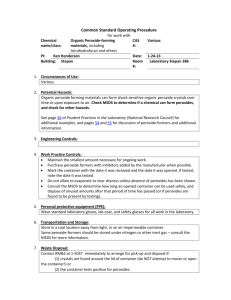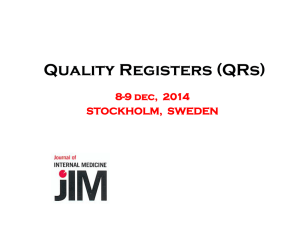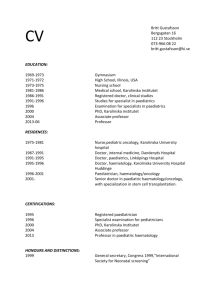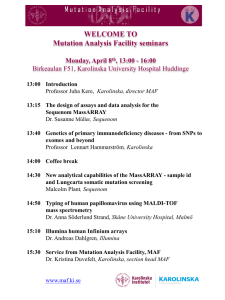Instructions for the handling of chemicals that can form explosive
advertisement
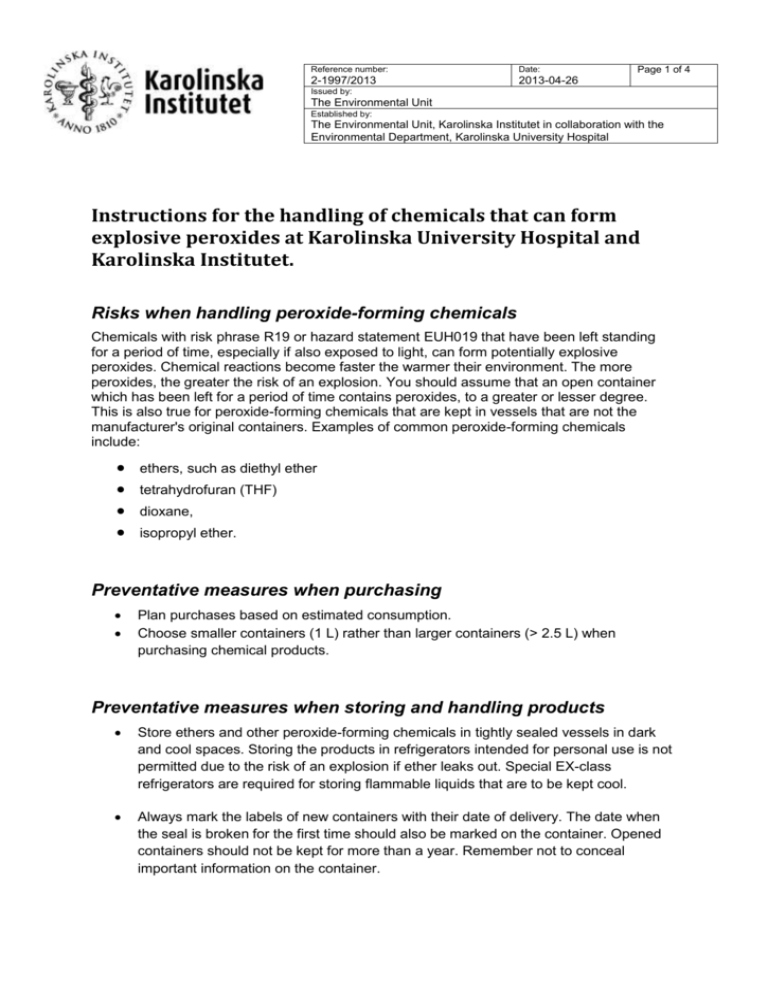
Reference number: Date: 2-1997/2013 2013-04-26 Page 1 of 4 Issued by: The Environmental Unit Established by: The Environmental Unit, Karolinska Institutet in collaboration with the Environmental Department, Karolinska University Hospital Instructions for the handling of chemicals that can form explosive peroxides at Karolinska University Hospital and Karolinska Institutet. Risks when handling peroxide-forming chemicals Chemicals with risk phrase R19 or hazard statement EUH019 that have been left standing for a period of time, especially if also exposed to light, can form potentially explosive peroxides. Chemical reactions become faster the warmer their environment. The more peroxides, the greater the risk of an explosion. You should assume that an open container which has been left for a period of time contains peroxides, to a greater or lesser degree. This is also true for peroxide-forming chemicals that are kept in vessels that are not the manufacturer's original containers. Examples of common peroxide-forming chemicals include: ethers, such as diethyl ether tetrahydrofuran (THF) dioxane, isopropyl ether. Preventative measures when purchasing Plan purchases based on estimated consumption. Choose smaller containers (1 L) rather than larger containers (> 2.5 L) when purchasing chemical products. Preventative measures when storing and handling products Store ethers and other peroxide-forming chemicals in tightly sealed vessels in dark and cool spaces. Storing the products in refrigerators intended for personal use is not permitted due to the risk of an explosion if ether leaks out. Special EX-class refrigerators are required for storing flammable liquids that are to be kept cool. Always mark the labels of new containers with their date of delivery. The date when the seal is broken for the first time should also be marked on the container. Opened containers should not be kept for more than a year. Remember not to conceal important information on the container. Reference number: Date: 2-1997/2013 2013-04-26 Page 2 of 4 Issued by: The Environmental Unit Established by: The Environmental Unit, Karolinska Institutet in collaboration with the Environmental Department, Karolinska University Hospital An inhibitor is generally added to prevent peroxide formation. However, the risk of peroxide formation increases the longer the solvent is exposed to air (the inhibitor is consumed) or if the solvent has been purified (for example through distillation). Old and half-empty flasks should therefore be closely monitored. How long it takes for a dangerous amount of peroxides to be formed depends on how the peroxide-forming chemical is stored. Peroxide controls Note: Tests may only be carried out by a chemist with experience of working with peroxides! (Each unit whose work involves chemicals that may form peroxides is responsible for designing local safety procedures that are adapted to the unit's work procedures.) Peroxide test is most easily carried out with the aid of sample sticks, such as Sigma-Aldrich Quantofix 1-100 mg/L (semi-quantitative test). a) Peroxide-forming chemicals should be checked regularly for any peroxide formation. Chemicals with a clearly detectable peroxide content ( ≥ 3 mg/L) should not be used. b) If a solution is turbid, discoloured or if crystals are present, the container should not be touched. In that case, chemical administrators from the Environmental Department (Karolinska University Hospital) or the Environment and Safety Unit* (Karolinska Institutet) should be contacted for assessment and handling of the chemicals. c) Always conduct a peroxide test before a peroxide-forming chemical is used. o If the peroxide content is less than 3 mg/L, the chemical can be used. o If the peroxide content is more than 3 mg/L but less than 30 mg/L, the chemical should be disposed in accordance with 'Disposal procedure', below. o If the peroxide content exceeds 30 mg/L, chemical administrators from the Environmental Department (Karolinska University Hospital) or the Environment and Safety Unit* (Karolinska Institutet) should be contacted for assessment and handling of the chemicals. d) Opened containers are not to be kept for more than a year. e) Unopened containers of peroxide-forming chemicals (NB! clear solutions) that have passed their expiry date should be analysed for peroxides. If the peroxide content is less than 30 mg/L, the chemical can be disposed in accordance with 'Disposal procedures', below. In case of higher peroxide levels, contact chemical administrators (from the Environmental Department or the Environment and Safety Unit*) for assessment and handling of the chemicals. f) Do not mix peroxide-forming chemicals with other chemical solution waste. Leftover ethers should be allowed to evaporate in fume cupboards. No more than 1 litre may be left to evaporate at the same time. Remember not to leave heat sources in the fume Reference number: Date: 2-1997/2013 2013-04-26 Page 3 of 4 Issued by: The Environmental Unit Established by: The Environmental Unit, Karolinska Institutet in collaboration with the Environmental Department, Karolinska University Hospital cupboard as they may ignite, especially, diethyl ether. Diethyl ether has a low flash point and can "flow" along surfaces and ignite on hot plates, for example. Evaporation should be carried out overnight. Fume cupboards where ethers are left to evaporate must be connected to the exhaust air system. * The Environmental Unit until 30 June 2013, Note: If a solution is turbid, discoloured or when the contents have evaporated and show signs of precipitation/crystal formation, the container should not be touched/moved. Even in cases of major peroxide formation, the chemical is not dangerous unless disturbed. The label should state: Warning: May form explosive peroxides! Date received: Date opened: Peroxide test results (mg/L) (Peroxide tests should be conducted every six months) Date: Date: Date: Result: Result: Result: … …. Initial: Initial: Initial: If you wish to dispose old peroxide containing chemicals You should not personally handle solutions with a high peroxide content. Contact the Environmental Department (Karolinska University Hospital) or the Environment and Safety Unit* (Karolinska Institutet) in the following situations: When the contents have evaporated and there is no liquid remaining, except precipitation or crystals. When the liquid is turbid (cloudy) or discoloured and/or there is precipitation or crystals on the bottom of the container. When you cannot see through the container and you know that it has been stored unsuitably (warm) or for a long period (more than 1 year). When you do not know how old the container is or how it has been stored. When you have detected a high peroxide concentration, > 30 mg/L. Reference number: Date: 2-1997/2013 2013-04-26 Page 4 of 4 Issued by: The Environmental Unit Established by: The Environmental Unit, Karolinska Institutet in collaboration with the Environmental Department, Karolinska University Hospital If you are unsure, contact the Environmental Department (Karolinska University Hospital) or the Environment and Safety Unit* (Karolinska Institutet). * The Environmental Unit until 30 June 2013 Disposal procedures When you wish to dispose of a potentially peroxide-forming chemical with a lower peroxide concentration (< 30 mg/L), the following applies: Move the container with the chemical, without touching the cap or any other seal and without shaking the container. Handle the product as chemical waste. Refer to the instructions for hazardous waste. Note: Peroxide-forming chemicals may not be poured into drains or onto the ground.
